| Courtney Kowalke |
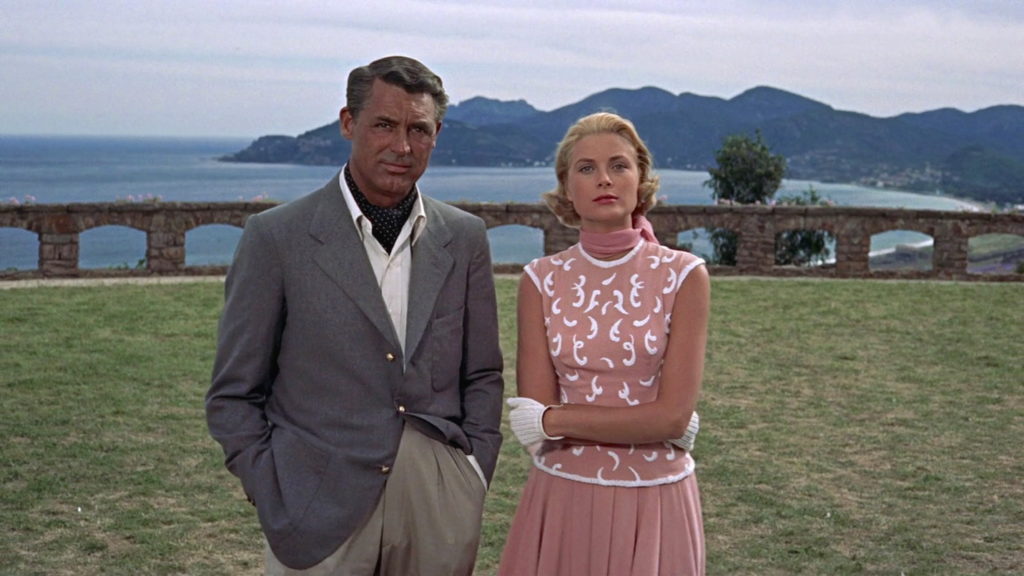
To Catch a Thief plays at the Heights Cinema on Thursday, April 20. Visit trylon.org for tickets and more information.
Does anyone who enjoys classic Hollywood films get sick of talking about Edith Head? I’m sure those people exist, but I’m not one of them. I’m actually a bigger fan of Head’s work styling Kim Novak in Vertigo, but if you want to discuss Head and Hitchcock, To Catch a Thief is the most obvious starting point. The film netted Head an Academy Award nomination for Best Costume Design, and according to her longtime friend and biographer David Chierichetti, To Catch a Thief was Head’s favorite film to work on.
Chris Polley gave Head and her work a shout-out in his post about Notorious a few weeks ago. It’s fitting that Polley also talked about excess in Hitchcock’s films because To Catch a Thief is a Technicolor explosion. Set in the south of France, the film was shot on location in the Alpes-Maritimes. The Mediterranean Sea and the sunny skies above it never looked so blue. The hillsides are verdant, the old coastal homes are cities of brick red and stark white. Even the nighttime scenes have green or teal hues (presumably because they were shot during the day and then had filters applied).
The film’s plot and setting are built-in excuses for the costuming to be excessive. Your typical Hitchcock protagonists are stylish but more-or-less average people. They can look good but not distractingly so. Here we’re focusing on a former jewel thief and a new thief’s über-wealthy marks. Head had permission to get extravagant.
There isn’t much I can write about Grace Kelly’s Frances Stevens that hasn’t been written before. Maybe I only think that because I spent too much time researching this piece, but she’s all anyone talks about when they discuss To Catch a Thief’s costuming. Kelly was Edith Head’s muse and one of Hitchcock’s favorite leading ladies. Frances is the beauty and the brains of the movie, and as the romantic lead, of course she’s designed to turn heads. She’s an ice princess, wearing primarily pastels and white. She floats around in chiffon, typically with some kind of long neck scarf or shawl. Frances and her fashion arguably make the movie iconic.
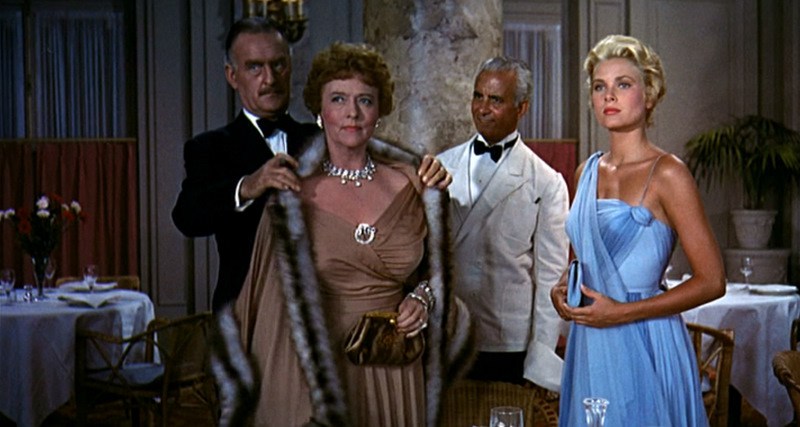
It’s understandable why Frances gets the lion’s share of attention when people talk about To Catch a Thief, but I’d like to look at my favorite character in the movie—her mother, Jessie Stevens (Jessie Royce Landis). Jessie could not be more unlike her daughter. She’s introduced wearing a diamond necklace, three diamond bracelets, a pair of diamond earrings, two rings, and what might be a brooch if it’s not a gem sewn into the chest of her dress. Shortly after, she puts on a fur stole. When insurance agent H. H. Hughson (John Williams—not the composer) asks if she wouldn’t feel more comfortable leaving some of those baubles back in her hotel room safe, Jessie retorts that she bought these things to wear, not to collect dust or to sit around looking pretty. Jessie is a bold, bourbon-drinking nouveau riche, who is in France to have fun and to find a husband for Frances. I’m honestly surprised her costumes aren’t more colorful, although she does make up for it in the jewelry department. Jessie’s final dress is a sumptuous navy blue ballgown, a deep hue that contrasts with her daughter’s iconic gold lamé confection. She also sports a fun purple pantsuit early on. For the most part, though, Jessie sticks with earthy tones like tan, beige, peach, and even light pink, which visually ties her to Frances. I’m especially fond of one small detail: in one short scene where they’re walking down the street together, Jessie wears a pantsuit with a long, chiffon, floral-print scarf around her neck, much like ones we see Frances wear throughout the film.
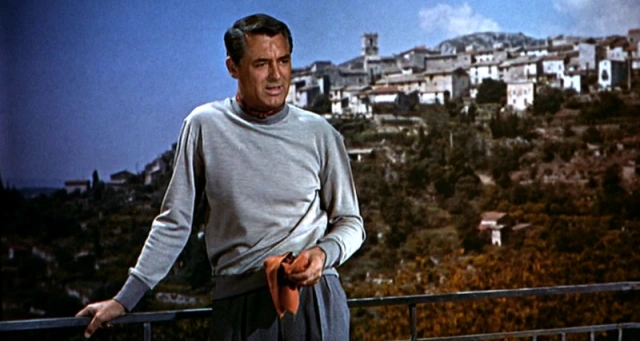
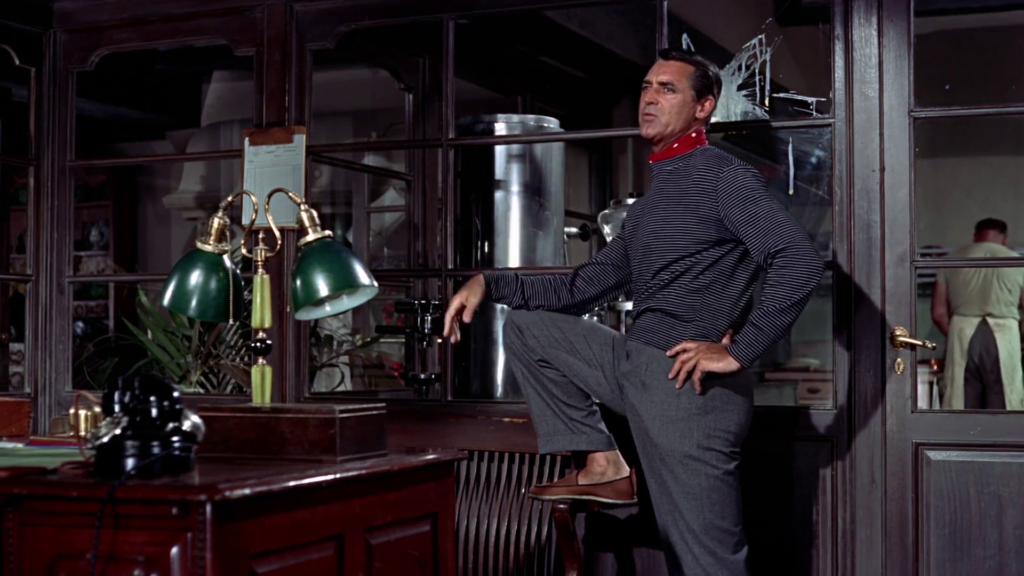
Fashion also plays a role in developing the character of retired jewel thief John “The Cat” Robie (Cary Grant). His first line of dialogue in the movie is, “Alright, but would you mind if I put on something more formal?” He doesn’t, spending most of the first act in a striped sweater and red polka dot ascot. It’s a look he adopts a few times through the movie, usually when he’s at home in his villa, but an understated neck scarf does show up in his wardrobe even when Robie is undercover as Conrad Burns. It was reportedly a style many men tried to emulate back when To Catch a Thief came out, and a style that sticks around in the public conscious to this day. I wasn’t surprised to hear in a video interview for Vanity Fair that director Rian Johnson took inspiration from Robie for Benoit Blanc’s outfits in the 2022 movie Glass Onion: A Knives Out Mystery. The ascot was a dead giveaway.
Robie’s sense of style is important to his character because, while he is retired now, he wants the finer things in life. He likes nice things. He pursues them. Robie explains to Hughson that he started robbing people because he wanted a more luxurious lifestyle. He wasn’t a Robin Hood type—he kept everything he stole for himself. Robie is cultivating this image on purpose, so his clothes are definitely worth paying attention to because he puts effort into how he presents himself. This attention to detail we can’t attribute to Head—Cary Grant was in charge of his own wardrobe. It’s a neat trick since the ascot also ties him visually to Frances and her neck scarves. Maybe that’s something they can bond over after the honeymoon.
Late in the movie, Robie attends a funeral wearing a light gray suit with a dark gray tie. I found it odd at first that Robie wasn’t wearing black, but upon further inspection most of the other mourners aren’t either. Besides, we have the rest of the movie for that— “The Cat” comes back, and Robie spends the final scenes wearing a black sweater and slacks while prowling in the shadows and using his expertise to finally catch the real thief.
The costume choices for Monsieur Bertani (Charles Vanel) also caught my eye. Bertani is a French restaurateur employing many of the former criminals Robie was in the resistance with; on the surface he’s a legitimate businessman, but he has the connections to get Robie away from the police in a matter of minutes in the opening act. For most of his screen time, Bertani wears a beige suit, a white shirt, and a beige tie. He’s boring. He’s forgettable. You would not look at this man twice if you saw him in public. He doesn’t draw attention to himself by design—someone who looks that inconspicuous can’t possibly have any secrets worth investigating.
Bertani also shows up at Foussard’s funeral wearing a navy blue suit and a light blue-gray tie. This amused me because once he stands next to Robie and the two strike up a conversation, his costume is nearly an inversion of the colors Robie is wearing. It’s some incredibly subtle foreshadowing for the final minutes of the film.
Head also gets to do some fun things with Danielle Foussard (Brigitte Auber), a French teenager with a crush on Robie. Robie was in the French Resistance with Danielle’s father; he still sees Danielle as a little kid, and this is reflected in Danielle’s costuming. She is introduced wearing a striped sweater, the thin red and white lines making the piece look light pink from afar, and a dark pink skirt. Danielle later shows up on the beach in a white halter swimsuit with teal-patterned stripes down the front. When Frances swims up in a plain, black halter swimsuit a few seconds later, the contrast between the two women is clear. Danielle is youthful. Danielle is adorable. Danielle is not as much a part of Robie’s mature and glamorous world as she desperately wants to be.
Danielle is also one of the few characters wearing true black at the aforementioned funeral. After the service, Frances is waiting for Robie outside, and Head’s costumes once again show how the two women are foils. Whereas Danielle wears a long, black coat and a black headscarf, Frances arrives wearing a soft, cream coat with her bright blonde hair uncovered.
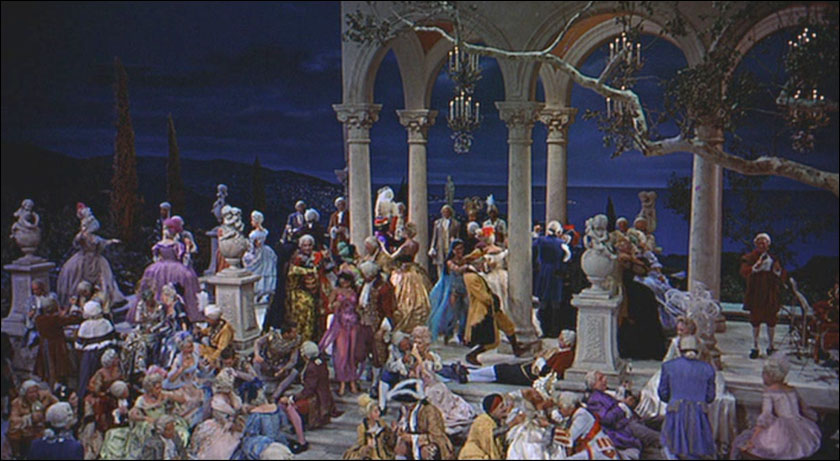
Head also got to run riot with the climactic costume ball. The masquerade’s theme is “18th Century France,” and we’re treated to many 1750-by-way-of-the-1950s ensembles. (I invite viewers to keep an eye out for my favorite guest, the blonde wearing a black-and-pink rococo dress along with cat eye glasses.) Unlike in Notorious, the men get to have some fun here—while most of them stick to standard black, navy, cream, and tan hues, two of the undercover policemen wear pink costumes to the ball, a third wears light blue, and a fourth wears a rusty, burnt-orange outfits.
I have questions about some of the masquerade costumes, though. Robie goes undercover as a Moor servant, trailing behind the Stevens women and holding a fan over them. He wears a black mask that fully covers his face instead of any skin-darkening makeup, so it’s not as racist as it could have been, I guess. It still gave me pause, though, as did several other men wearing turbans and women wearing harem pants. (One of these couples is a Black man and an Indian woman, so they get a pass. Everyone else is on thin ice, though.) I wasn’t sure what the connection was between these “exotic” types of dress and Louis XV’s court, and my Internet searching mainly gave me articles about the current French court system banning Sikh children from wearing turbans in school, which was unhelpful in this context. In the end, I read way too much about the French colonization of India and the Carnatic Wars for somebody who only came here to talk about pretty gowns.
Much like I thought the inclusion of more women in The 39 Steps made for a more developed fictional world, I think all the detail put into the costumes of To Catch a Thief serves to make the movie richer (pun intended). It adds to the film’s visual language. The attention to these details conveys things about its characters without dialogue. When that kind of love and care goes into your craft, you don’t have to draw blatant attention to it—it bursts right through the seams.
Edited by Olga Tchepikova-Treon
